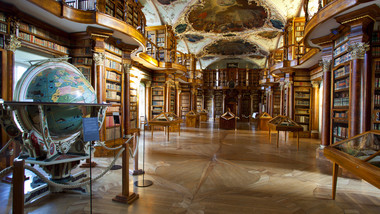A monastery, a library, a World Heritage Site. St. Gallen – since 612!
04.03.2021
A monastery, a library, a World Heritage Site. St. Gallen – since 612!
When the Irish wandering monk Gallus and his deacon Hiltibod built the first cell above the shores of Lake Constance in 612, they could not have imagined that centuries later a monastery would arise and become the spiritual centre of the Occident in the Middle Ages. After the foundation of the Abbey of Saint Gall, the first abbot Otmar laid the foundation for its rise to one of the most important monasteries of its time. Today, the UNESCO World Heritage Site Abbey District of Saint Gall delights visitors with its baroque architecture, the third oldest library in the world and the oldest monastic plans.
ST. GALLEN – SINCE 612
In the year of our Lord 612, the Irish wandering monk Gallus came to Lake Constance as a companion of Abbot Columban, from where he and his companions went their separate ways. Together with his deacon Hiltibold, he set off along the Steinach river to the present site of the city of St. Gallen. Legend has it that a fateful encounter with a bear caused Gallus to stay. Thus he founded the first cell in 612 and has since been considered the founding father of the city of St. Gallen.
The spiritual centre of Europe
In 719, a century later, the Gallus settlement was revived by Otmar. This gave rise to the Abbey of Saint Gall, which, with its imposing, double-towered cathedral, became an important spiritual centre in Europe. It was a haven of culture and a place of great radiance. Numerous manuscripts and documents from its heyday have been preserved. They are of central importance for the study of the early Middle Ages. UNESCO declared the Abbey District with the Abbey Library a World Heritage Site in 1983.
Rococo, monastic plans and a mummy
Probably the best known and most popular building on the monastery grounds today is the Abbey Library. Every year, thousands of visitors shuffle reverently in slippers across the wood-panelled floor of the Benedictine monks’ former writing room. The magnificent, curved hall with its ornamented inlaid floors, the wood-panelled, columned bookcases and richly stuccoed ceiling paintings is a baroque work of art in its own right. The monks are gone today, but their library houses tens of thousands of priceless written documents. Here, in one of the most beautiful rococo halls in the world, 170,000 printed books and, in temporary exhibitions, unique copies of the 2,000 original medieval manuscripts can be admired. This is the first time that the public has been able to see the famous original of the 9th-century monastic plans of Saint Gall, displayed in the exhibition hall since 2019. The parchment is the earliest drawing of a monastic compound from the Middle Ages. It was probably made between 819 and 826 in the monastery of Reichenau on Lake Constance and is in the possession of the Abbey Library of Saint Gall. Another tourist attraction is Schepenese’s mummy, which rests in the Abbey Library together with its two coffins. Schepenese was a priest’s daughter who lived in Thebes between 700 and 650 BC and ranked among the elite of that city. Her mummy with its richly painted interior and exterior coffins came to St. Gallen in 1821.
Historical exhibits from the history of the monastery
The new attractive permanent exhibition about Gallus, his monastery and the 1,400-year cultural history of the place can be visited in the vaulted cellar of the Abbey Library, formerly the lapidarium. It exhibits important originals from the monastery’s history, including the magnificent Evangelium longum with Tuotilo’s ivory carvings (around 895), as well as the capitals of the Gozbert Minster (around 830). The vaulted cellar was modernised in 2019 and offers visitors a varied experience.
Contact
St.Gallen-Bodensee TourismusTobias Treichler
Vizedirektor / Leiter Marketing
Bankgasse 9
CH-9001 St. Gallen

